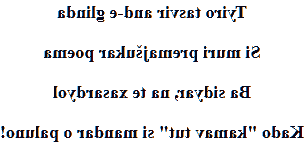Romani love poem
Oglindă
Tyiro tasvir and-e glinda
Si muri premajšukar poema
Ba sidyar, na te xasardyol
Kado "kamav tut" si mandar o paluno!
poet, translator and Lovari language teacher


→ French poem ←
Bohemian woman & romani
Gypsy, carmen you will be always the most beautiful among bohemians girls. A day, from your caravan, while surfing on the web, you will see your picture in a mirror.
This translation into Romani (lovari) of my love poem, will send me back, all the magic reflection of your mirror. You will contact me, and it's me who will come to see you, by the fire, to see with you, fly the dresses of the flamenco dancers.
Lovari (alternatives : Romani, Rromani, Roma, Rromanès, Romany, Vlax, Greco, Kelderashícko, Coppersmith, Tsingani, Vlax Romani, Sedentary Bulgarian, Arli, Rom, Central Vlax Romani, Southern Vlax Romani, Bisa, Gurbet, Tsigane, Machwaya, Romenes, South Albanian, Churari, Sinto, Machvano, Romanés, Eastern Vlax Romani, Sedentary Romanian, Vlax Romany, Sievemakers, Romanese, Zagundzi, Serbo-Bosnian, Machvanmcko, Churarícko, Ghagar, Zigenare, North Albanian, Danubian, Kalderash, Gypsy, Lovarícko, Tsigene, Ukraine-Moldavia, Kaldarári, Grekurja, Southern Vlax) Selam Pató Romani (Lovari) is the Indo-Aryan language, of the banjara momad tribes from northwestern India.
4.5 million people in many countries will understand this translation. Here my translated poem is in the Gypsy language of Hungary.
Romani is the only Indo-Aryan language spoken exclusively in Europe, as well as by some emigrants in Australia and Americas. This language can also takes the name of the people who speak it (Gypsy, Rom etc.) These populations spread across different European countries all speak a Rom language, which has its own dialectal characteristics.The most important concentrations are in Central Europe, and southeastern Europe (Macedonia, Bulgaria, Romania, and Slovakia).
Romani is a language of oral tradition, and by tradition, this orality has the vocation to protect secrets. It is only in 1990 that this language start to be written, a language that is now used by the media, and on the internet, more rarely in schools.
It is in the middle of the 16th century in Europe, that we speak for the first time about Romani. Since our knowledge about this language, and its history, is based on the comparison that can be made with the other Indo-Aryan languages, and languages, with which it has been in contact. Obviously this language shares a lot with Sanskrit and more precisely with the Indo-Central languages.
It is thought that the people who speak Romani came from this central area, then, first went to the north, to finally leave India. This is what linguistics teaches us, by showing in Proto-Romani, a form of hybridization between the dialects of north and center.
It is also thought that this departure from the Indian continent could be around the 10th century. Subsequently this language will be influenced by Armenian and Iranian languages, then on its arrival in Europe, by the Greek. The separation of this mother tongue into dialects, will occur in the 14th century, when different groups will disperse from the Balkans to Western and Northern Europe, their settlements will be in the 16-17th century.
There are many varieties of Gypsy language, which are the result of contact with surrounding languages.
Gypsies
Gypsies have long been nomads. Originally from the Sind, the climatic vagaries, forced them to exile towards Mesopotamia, from where they will leave, to flee the wars carried against them, and will go towards Greece. Another wave of emigration will direct them to Europe, the Baltic States and Russia. Their communities take different names, depending on where they live. Rom comes from Romané Chavé (son of Ram), hero of Ramayana, Manouche comes from Sanskrit (human being), vlach, kalo (e) (brown) etc. are all names that designate them.
Although without written tradition, the Gypsy was stayed very alive, perhaps because of its use as a secret language; He has also permeated many slangs in various European countries. The music of the Gypsies is varied, because they have generally adapted the autochthonous repertoire.
This music is their poetry, their poems are sung. They have preserved their language and beliefs and are divided into three groups: the Roma located in Central Europe, the Sinte mainly in Italy, and the Kale mainly in Spain and Portugal.
Sinto love poem